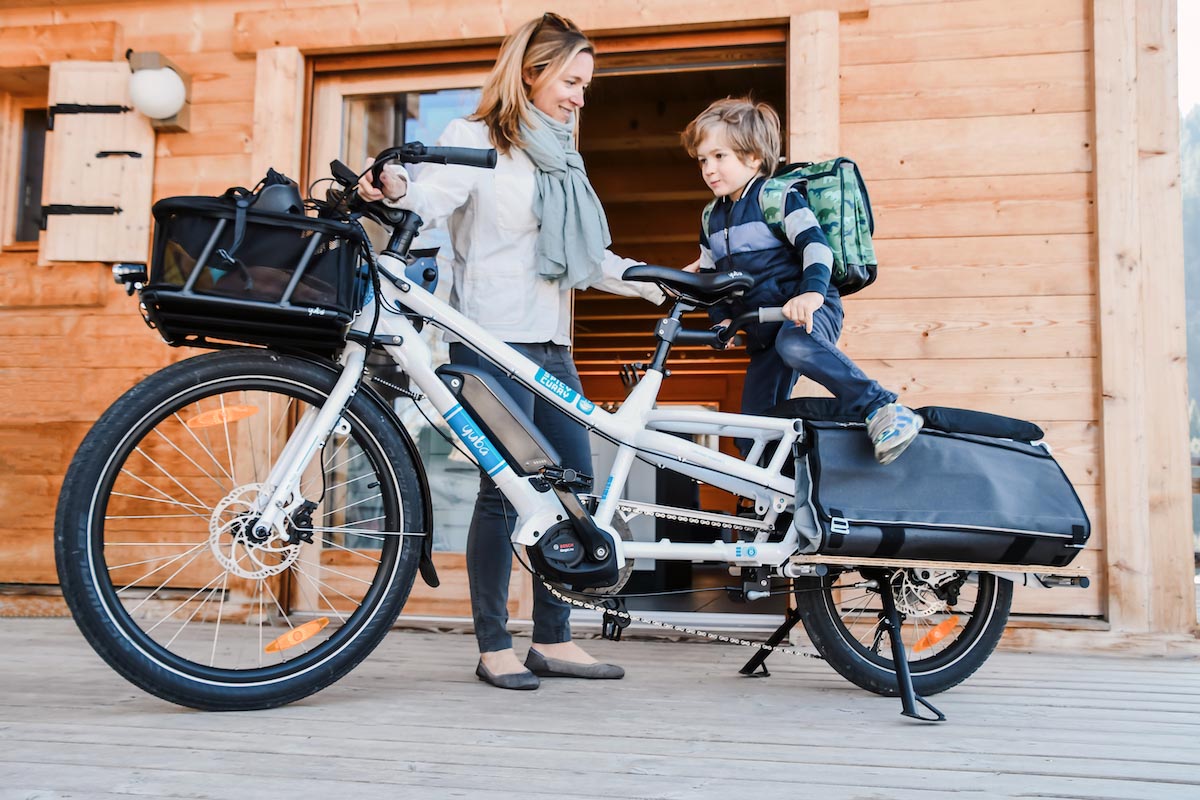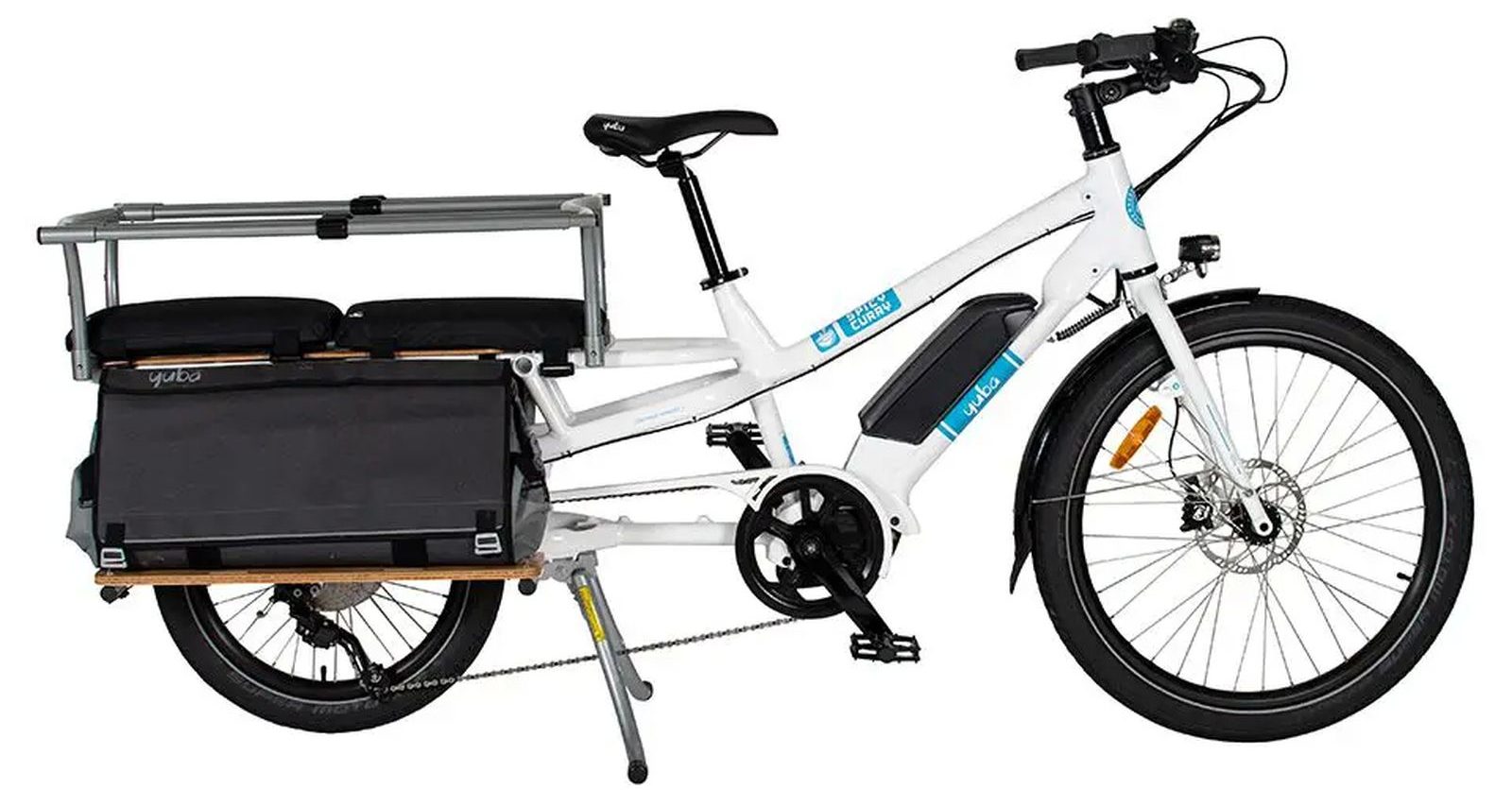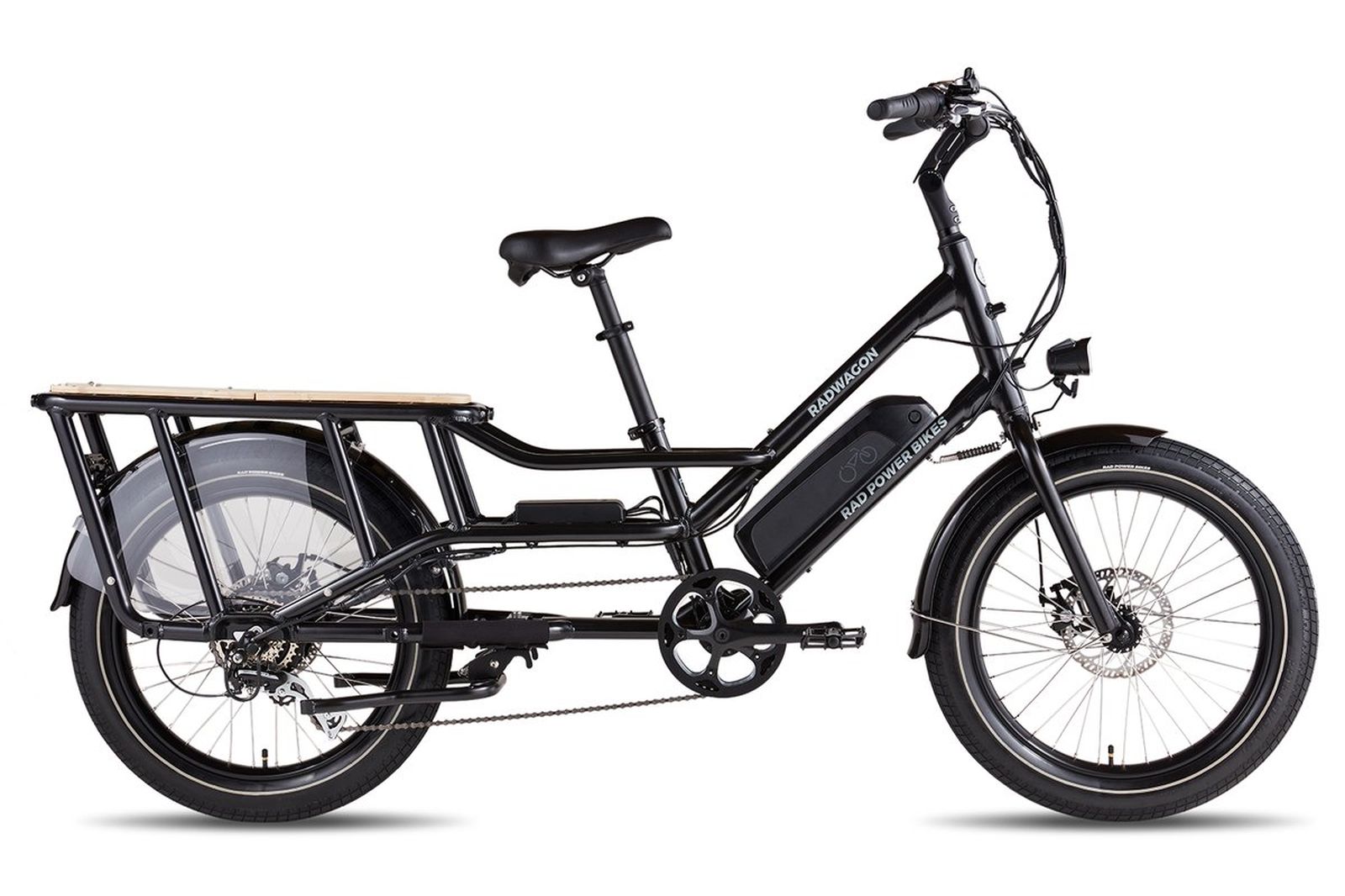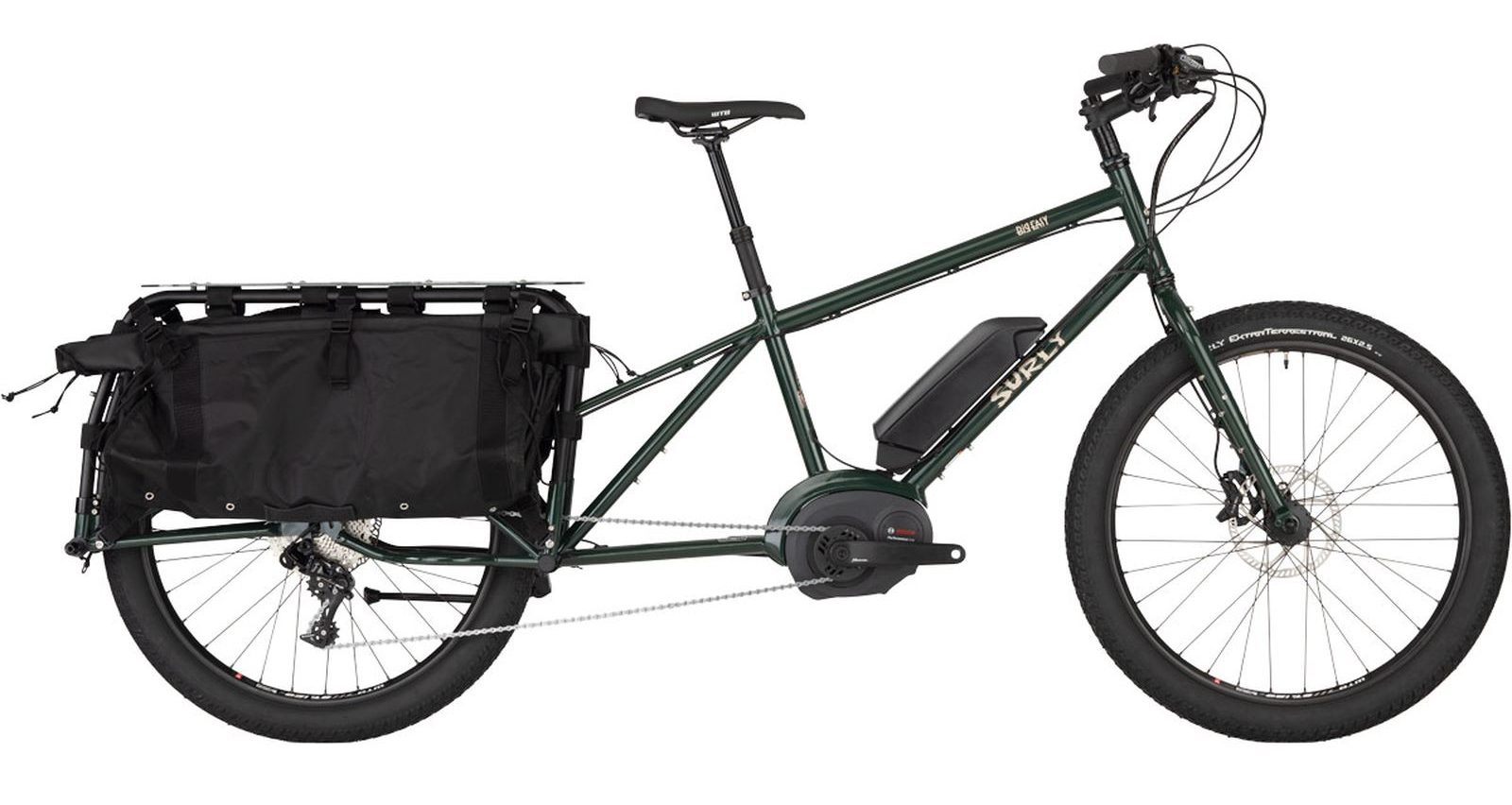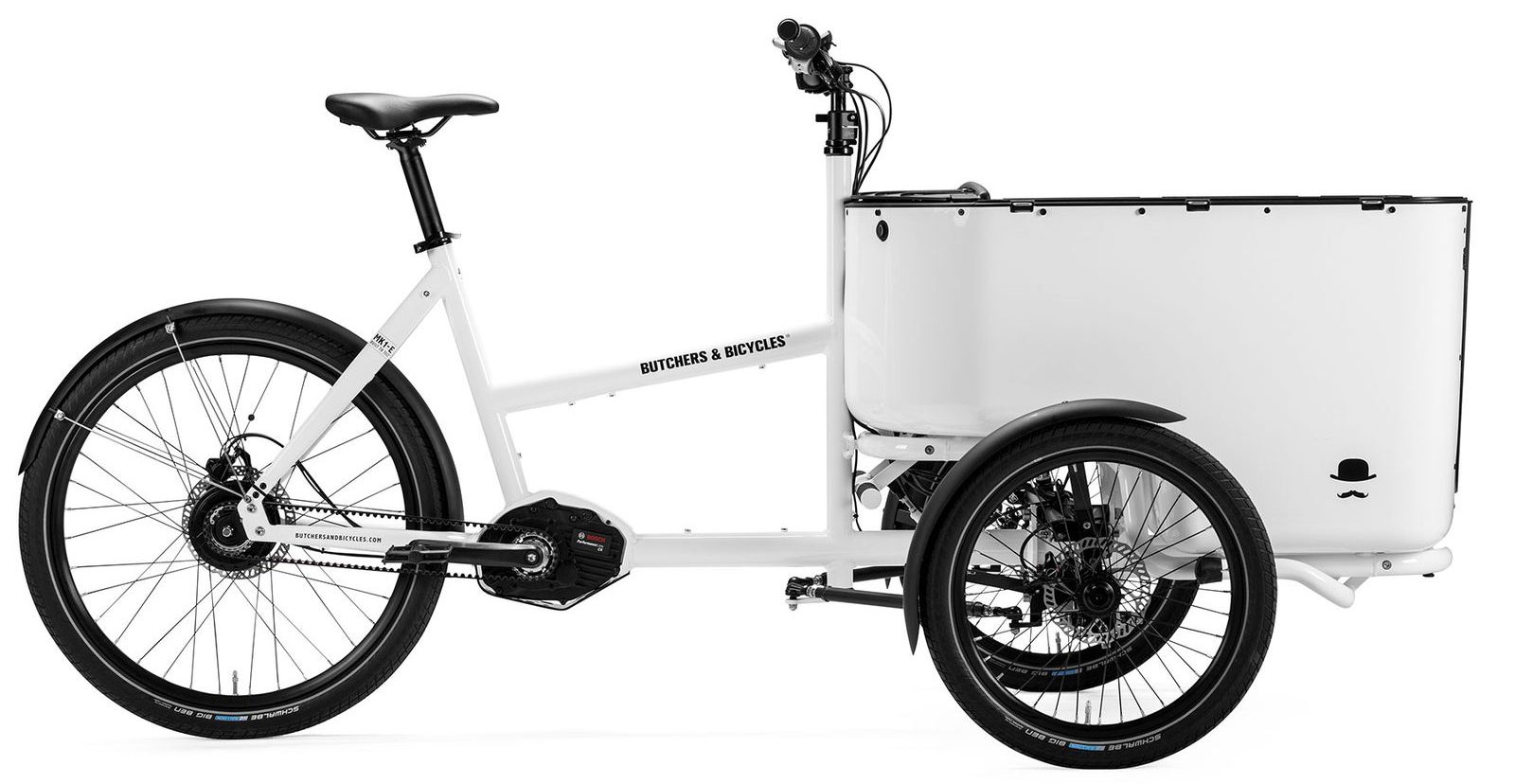If you’re trying to trade one of the family cars for a bike, but find running errands or toting kids to school is impossible on your regular commuter bike, investing in a cargo e-bike might be the optimal solution.
These electric-assist bikes can not only help you pedal along up to 20mph, they can do so while carrying a full load of groceries, your golden retriever, two small kids, or a date! Here, we’ve rounded up our favorite e-cargo bikes that have taken the place of a family van or second car for many of the Bikerumor editors.
BEST OVERALL: Yuba Spicy Curry
The Yuba Spicy Curry was one of the first cargo e-bikes introduced to the American market, and it keeps getting better. With a 440-pound total capacity (including you as the rider), it can carry a Costco shopping trip with no problem at all. It’s the priciest on the list, but this bike will last for many years, and the whole family will love it: While it’s one-size-fits-all, it can be adjusted for riders from 4’7″ to 6’4″.
We also love that there are tons of great add-ons from the brand, and you can kit out the bike by adding extra baskets, child-friendly seats, and other smart extras (we highly recommend adding the front basket). Unlike some cargo e-bikes, this one also comes with full fenders and front and rear lights already mounted. Check out our full review of the Yuba Spicy Curry right here.
- Cargo info: Rear, 440 pound capacity for total payload (including rider)
- Drivetrain: Shimano Deore
- Wheel sizes: 26″
- Brakes: Magura MT32 hydraulic disc
- Motor: Mid-motor
- Battery (capacity Wh): 400 Wh
- Max speed (Class): 20 mph top speed, Class 1
- Weight: 66 pounds
- Sizes: One size fits all (Yuba recommends use for riders 4’7″ to 6’4″)
- Color: Blue, red, white
- Included extras: Fenders, front and rear lights, plus your choice of custom add-ons when buying
- MSRP: $4,900
PROS: Great load capacity, easy to ride
CONS: Add-ons get expensive
BEST BUDGET: Rad Power Bikes RadWagon 4
At $1,900, we were incredibly impressed with the Rad Power Bikes RadWagon 4 as our budget-friendly model. Even if you’re ditching the car in order to save money on payments, gas, and annual insurance, and while we do think a good cargo e-bike is worth the price, we know not everyone can afford a $4K+ price tag.
The RadWagon 4 is a great starting point. With fenders and front and rear lights, plus a rear cargo panel, it can easily be upgraded with big panniers for larger grocery runs, or with child-friendly seats. With a solid motor and battery capacity, you won’t run out of charge quickly. The cost savings come from the components: The battery is a Samsung rather than the more widely respected Bosch or Shimano systems, and the brakes are mechanical rather than a hydraulic disc. Additionally, the tires are a custom 22″ diameter—making replacements harder to find.
- Cargo: Rear, 120 pound capacity
- Drivetrain: Shimano 8-speed
- Wheel sizes: 22″
- Brakes: Tektro Aries Mechanical Disc
- Motor: Hub
- Battery (capacity Wh): 750Wh
- Max speed (Class): 20 mph top speed, Class 1
- Weight: 76.7 lb
- Sizes: Optimal for 25.5 to 34.5-inch legs
- Color: Black, White, Red
- Included extras: Lights, fenders
- MSRP: $1,899
PROS: Great price, works well with accessories
CONS: 22″ tires aren’t easy to replace
BEST LOW-KEY CARGO EBIKE: Surly Big Easy
It may be pricy, but if you’re looking for a bike that does it all, the Surly Big Easy is our favorite thanks to its stealthy, sleek design. Most cargo ebikes are bulky, but the Big Easy uses the brand’s classic thinner steel tubes for the frame, making a bike that looks more like a backcountry bikepacking rig than an ebike that you’re riding to your local farmer’s market.
It has an impressive back rack capacity: Up to 200 pounds for cargo alone. Bonus: If you need even more capacity, this frame integrates with Surly’s Bill and Ted trailers for maximum cargo potential. Bring the kids to the grocery store without giving up cargo space!
It’s one of the few that offers different frame sizes -small, medium, large- which means it may actually be more comfortable for you, but it makes sharing it with shorter or taller family members tough. For the price, we wished it came with lights and fenders, but it does include their custom panniers.
- Cargo info: Rear, 200 pound max capacity on rack
- Drivetrain: SRAM NX 11 speed
- Wheel sizes: 26″
- Brakes: Tektro Orion 4
- Motor: Mid-motor
- Battery (capacity Wh): 500Wh
- Max speed (Class): 20 mph top speed, Class 1
- Weight: 67.4 pounds
- Sizes: Small, medium, large
- Color: Green, tan
- Included extras: Panniers
- MSRP: $5,249
PROS: Integrates with trailers if you want to build up the minivan of cargo bikes
CONS: No lights or fenders included
BEST FOR SMALL SPACES: Benno Bikes RemiDemi
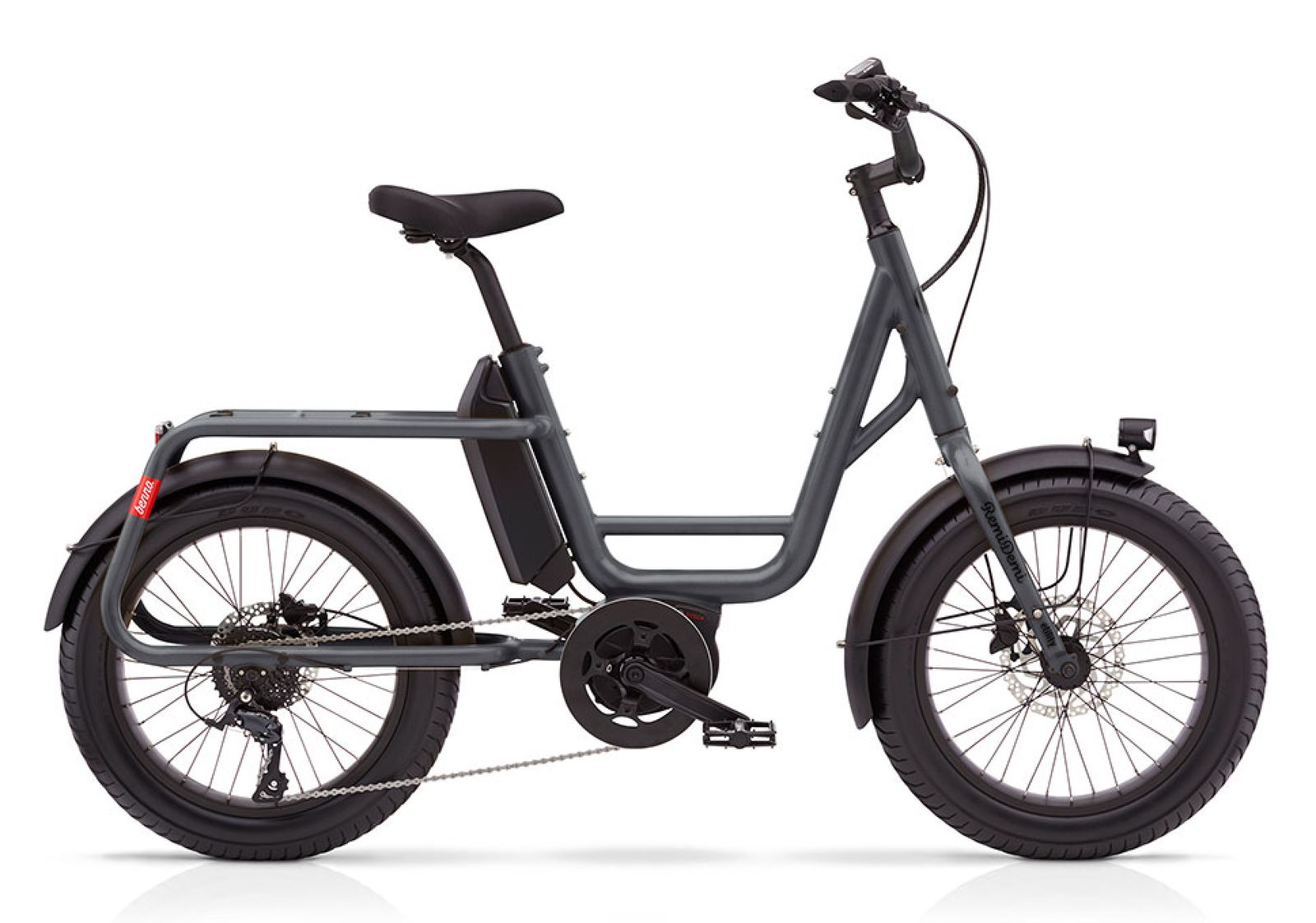 If you’re looking for a cargo bike that can fit in your apartment, we love the compact style of the Benno Bikes RemiDemi. With a smaller wheelbase and wheelset, plus a step-through frame, it looks less like a cargo ebike and more like a city bike. We also like that it has plenty of options for frame colors as well as accessories to build out your usable cargo space. You’re able to add a basket to the front to add 45 pounds worth of capacity.
If you’re looking for a cargo bike that can fit in your apartment, we love the compact style of the Benno Bikes RemiDemi. With a smaller wheelbase and wheelset, plus a step-through frame, it looks less like a cargo ebike and more like a city bike. We also like that it has plenty of options for frame colors as well as accessories to build out your usable cargo space. You’re able to add a basket to the front to add 45 pounds worth of capacity.
The bike isn’t quite as burly as the others: The capacity in front and rear is much lower. At only 65 pounds of cargo stowage in the back, it’s about half of what the other bikes can hold. However, if you’re using it for groceries and not pulling the whole family around town, that should be plenty. It’s also one size fits most (riders 5’1″ to 6’1″), so taller riders may struggle a bit. But that’s because the brand opted for 20″ wheels to keep the bike on the smaller side.
- Cargo info: Front and Rear, 45 pound capacity front, 65 pound capacity rear
- Drivetrain: Shimano Sora 9-Speed
- Wheel sizes: 20″
- Brakes: Shimano hydraulic disc
- Motor: Mid-motor
- Battery (capacity Wh): 400Wh
- Max speed (Class): 20 mph top speed, Class 1
- Weight: 65 pounds
- Sizes: One size, fits riders 5’1″ to 6’1″
- Color: Yellow, black, green, blue
- Included extras: Fenders, lights
- MSRP: $3,400
PROS: Decent price point, great looks, nimble handling
CONS: Needs accessories to use it as a cargo bike, taller riders may feel cramped
BEST FRONT CARGO: Butchers & Bicycles MK1
If you prefer to see your cargo when you pedal—whether you’re a flower delivery person or have kids that can’t be left on the back of the bike to their own devices without fighting—then the Butchers & Bicycles MK1 might be the bike for you. Normally, we don’t love trikes for their awkward handling, but this one allows the bike, including the entire cargo box, to ’tilt’ as it corners, making maneuvering around town much smoother…it feels and handles like a regular bike!
This bike is the biggest and heaviest at 108 pounds, so those who live in apartments with no ground floor bike storage should look elsewhere. It also comes with the heftiest price tag at $7260, but it comes with great spec like a Gates Belt Drive and higher power battery pack. For a front cargo bike hat actually rides well, it’s absolutely worth it.
- Cargo info: Front, max capacity 176 pounds
- Drivetrain: Gates CDX belt, 1×11 SRAM Derailleur
- Wheel sizes: 20″ in front, 26″ in rear
- Brakes: Tektro hydraulic disc
- Motor: Mid-motor
- Battery (capacity Wh): 500Wh
- Max speed (Class): 20 mph top speed
- Weight: 108 pounds
- Sizes: One size fits all (rider height between 5’1″ to 6’8″)
- Color: Black
- Included extras: ABUS Shield frame lock, Bosch Battery lock, Door for the cargo hold, fenders
- MSRP: $7,260
PROS: Great for toting kids or running errands, stays upright when loaded
CONS: Heavy, might have limited availability in North America
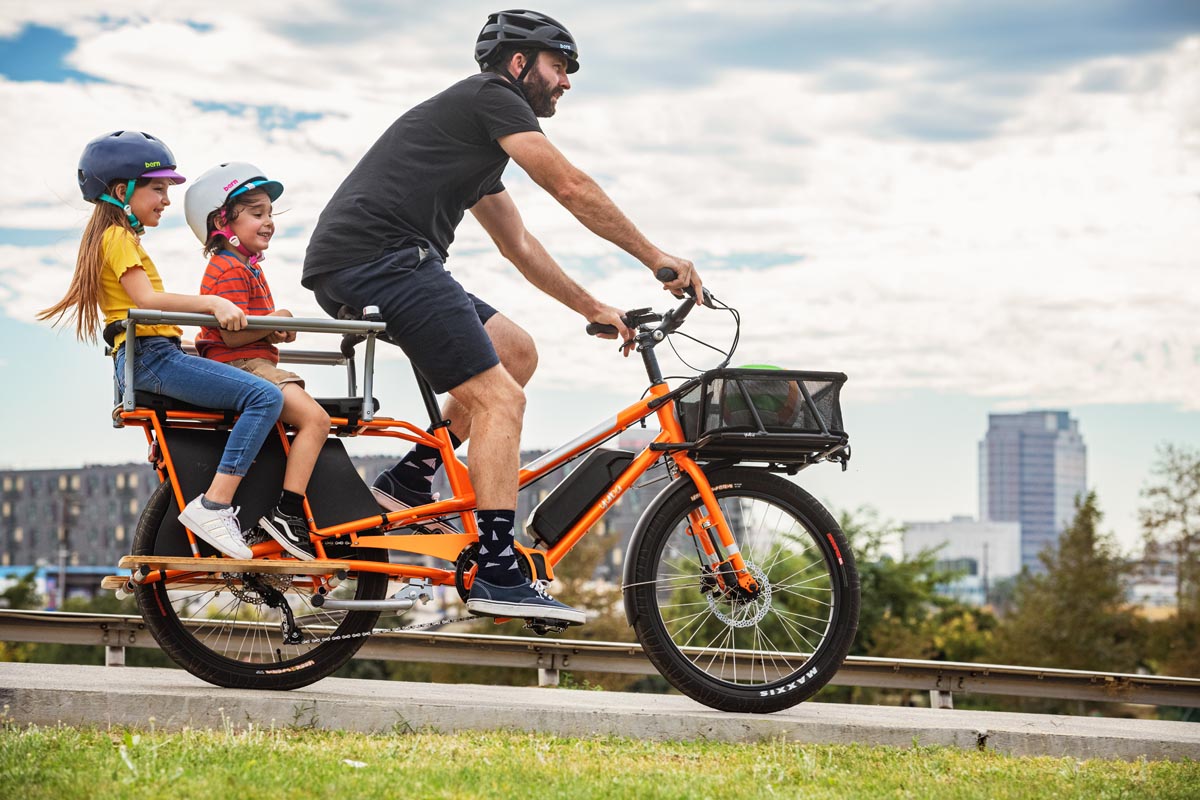
Cargo E-Bike Buyer’s Guide
MSRP: E-bikes are a pricey addition to your bike garage, and e-Cargo bikes usually more so. We’ll explain pricing in more detail below but expect to spend anywhere between $2500 and $5500 for a cargo e-bike that will last a long time.
Battery life: See below for a deeper dive into what battery specifications mean, but a higher Wh (Watt Hour) rating means more capacity and generally longer run times. And they should be rated for 900+ full charge cycles.
Weight: Don’t expect to find many cargo e-bikes that are under 70 pounds. Most are in the 60 to 80 pound range because the motors are heavy and the frames need to be heftier to accommodate those higher speeds and demands on them. But luckily, with an e-assist, weight is less of a problem and they don’t ride “heavy”.
Components: While you don’t need the fanciest components, mid-range tends to be the sweet spot. Avoid no-name components when possible, especially for drivetrain and brake systems. Some pieces, like tires, saddles, or bar grips are easy to replace, but a full drive train can easily cost $1,500 to upgrade. Spend now to save later.
Gearing: If you live in a hilly area, make sure it has low enough gearing that you can maintain a good 80-90 cadence on the steep hills, because even though there’s a motor, it can struggle if you’re left grinding through a too-hard gear at a really low cadence.
What are you carrying? If you’re focusing more on carrying kids to and from school, a bike that has kid-friendly seating options rather than one big cargo area might be ideal. But if you’re carrying a wide variety of stuff, something like the cargo hold on the Butchers and Bicycles MK1 might be ideal.
Extras: Look for things like locks for the e-bike and the battery, built-in lights, pre-attached racks, and full fenders. These shouldn’t determine your bike choice but are all nice accessories that can easily add hundreds to your bike shop bill after the fact, so if a bike comes with any, a factor that into the cost.
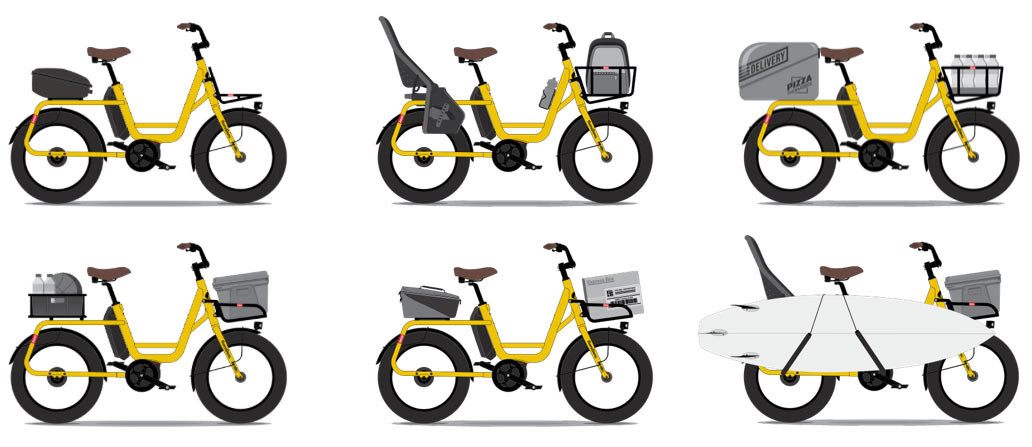
Frequently Asked Questions about Cargo E-Bikes
What is an ebike?
An ebike (aka electric-assist bicycle, e-bike, cargo e-bike, e-cargo bike, etc.) looks like a regular bike at a glance, but has an electric battery-powered motor that gives you a boost. You still need to do some work, but the motor can bring you up to much higher speeds, help you power up hills, and in the case of a cargo bike, help you tote a lot of gear.
Do I need a cargo bike?
Think about how you’re really going to use the bike. If you’re just going to and from work or school, you may also want to consider getting a commuter ebike that has room to attach a back rack and panniers.
If you’re looking to run all your errands on it, take kids to school, or bring your friend or S.O. along for the ride, you’ll want a cargo bike. Here’s why: They’re built to carry the weight, and the gearing is more appropriate for hauling heavy loads. And when you’re not carrying all of that? They work perfectly fine as a regular bike, too, just a bit bigger.
What kind of styles of cargo ebikes available?
Cargo ebikes typically come in front or rear load styles. Rear loading cargo ebikes may have attachments to put baskets on the front for more stowage space, but generally the bulk of your cargo will go on the back, usually distributed in panniers and on a rail that rests over the rear wheel.
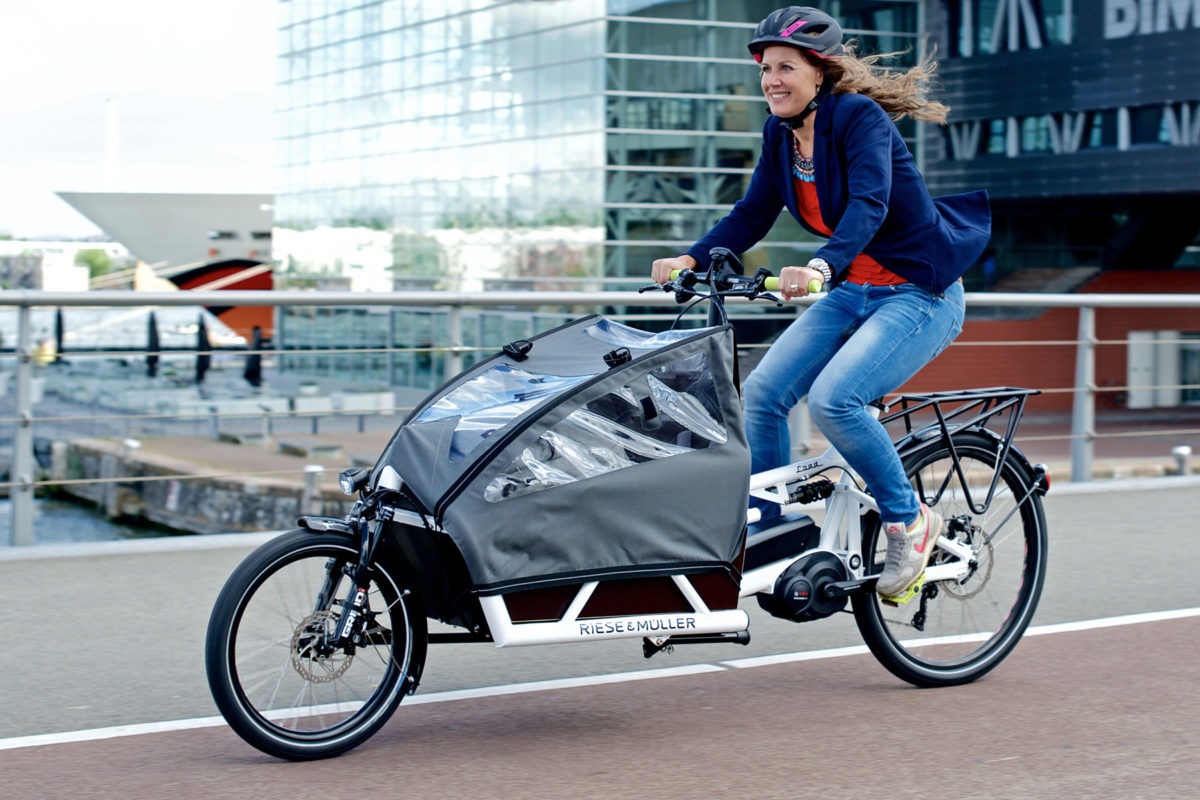
Front-loading cargo ebikes are typically bigger and longer than rear-loading bikes. Surprisingly, many still use only two wheels (like the Riese & Müller model shown above), which some folks love but can be a bit tricky to ride – they’re super long, which makes slow-speed handling a bit wonky, especially when loaded down.
And, unlike a trike, you have to be sure to balance and support the load at a stop. Most of us prefer front trikes or rear loaders over bakfiets, but if you more capacity in a streamlined shape, these two-wheel front cargo bikes are worth demoing.
What are the MSRP ranges for cargo e-bikes?
Expect to pay anywhere from $3,500 to $5,500 for a decent cargo ebike that has a brand-name battery and motor as well as brand-name components. This typically gets you good quality components and brand name parts.
Some models, like our budget option above, use lower-end components and mechanical disc brakes versus hydraulic disc brakes. They usually use hub motors cheaper batteries to bring the price down, too. While those options may be fine for most riders, if you plan to use the cargo ebike in lieu of a car, remember that an ebike is similar to a car – you get what you pay for.
What are the classes of ebike?
E-bikes are broken into Class 1 (maximum 20 MPH) and Class 3 (maximum 28 MPH), governed by the top speeds that they’re able to hit on electric-assist.
Don’t worry, if you’re pedaling downhill and your bike gets moving over 20 or 28MPH, the brakes won’t automatically come on to slow you down!
All of these cargo bikes are in the Class 1 category, partially because the demands of getting up to 28 MPH with hundreds of pounds of load are challenging for a small motor. But it’s also because in Europe, only Class 1 ebikes are allowed, and many cargo bikes are primarily sold in Europe, so it makes sense that manufacturers would stick with Class 1 worldwide. There’s a Class 2 category for bikes that have a throttle and don’t require you to pedal, but you typically don’t find those on cargo e-bikes.
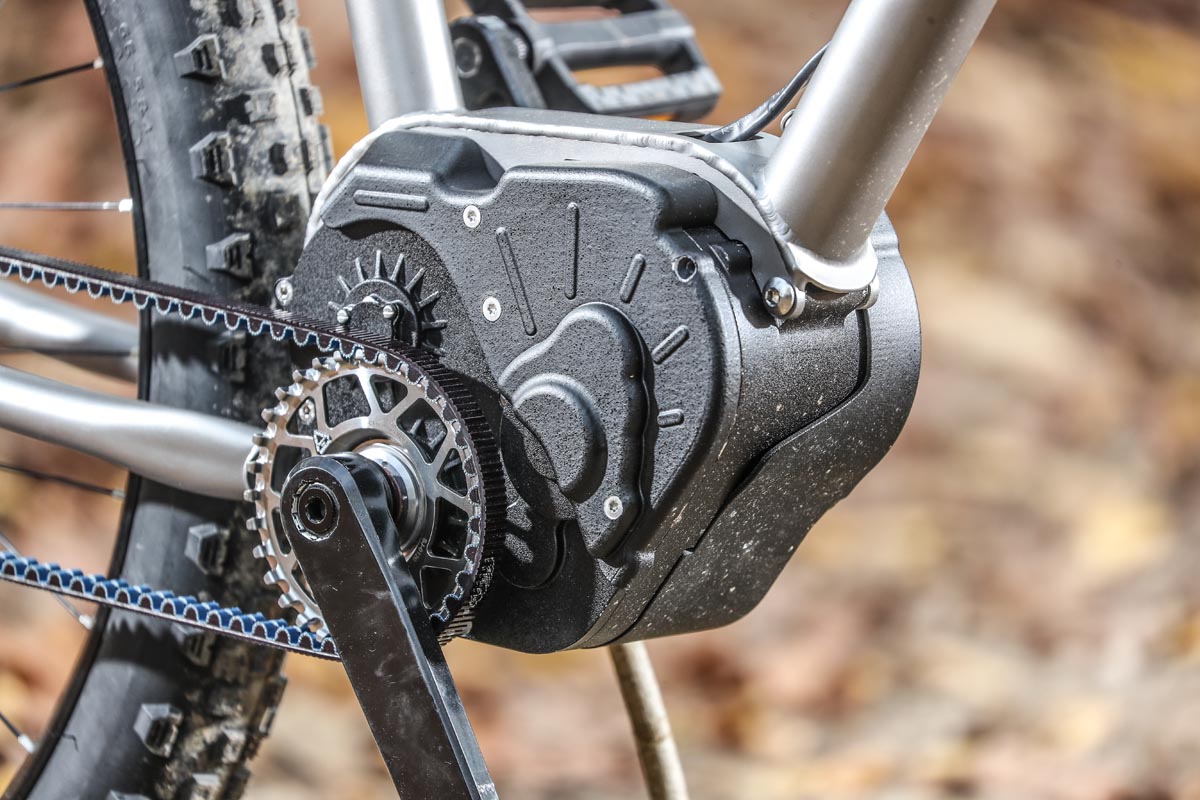
What are the pros and cons of hub motors versus integrated frame motors?
We prefer integrated frame motors (aka “mid motors”) because they use torque sensors to adjust power output based on your pedaling force. This lets them ease into the power as you start, offering a smoother riding experience that assists more when you need, less when you don’t. Mid-motor systems are typically more advanced and come with better batteries and software, too, but they’re more expensive.
Hub motors -motors concealed in the rear wheel hub- use cadence to govern the amount of electronic assistance that you’re getting. Meaning, as soon as you start pedaling, they start assisting at full power. Where a mid-motor senses your effort and adjusts accordingly, a hub motor relies on you to adjust the amount of assist using the +/- buttons on the handlebar.
Hub motors can feel like they’re launching you out of the gate, which is fun (sometimes), but can also be a bit disconcerting if you’re trying to slowly navigate a busy parking lot. They also typically use less sophisticated electronics and batteries, which is why they’re usually much less expensive. This doesn’t make them bad, just not as good as a mid-motor system.
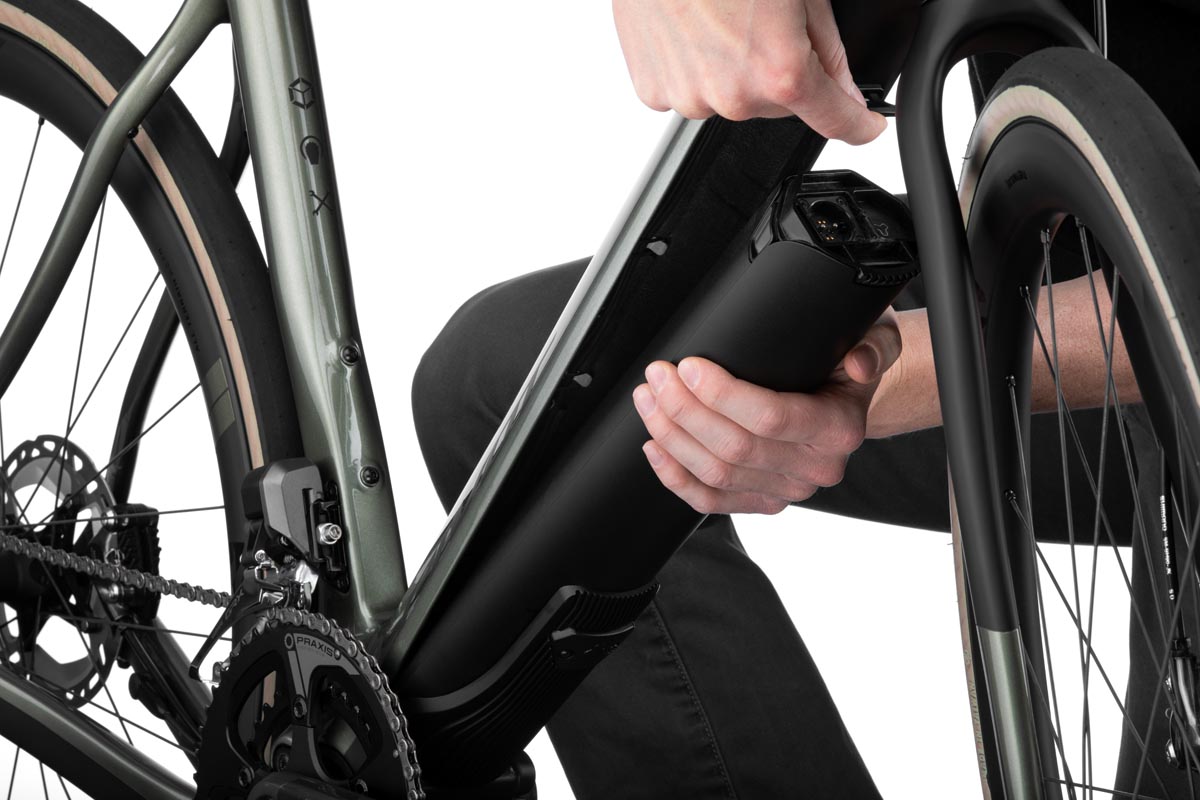
What do the battery and motor specifications mean?
We know that looking at e-bike battery specs is enough to make even an engineer’s eyes glaze over. But here are the basics that can help you make sense of those numbers.
- AMPS: An Amp is a measure of electrical current, also known as rate of flow. It’s how much power is moving through the system.
- VOLTS / VOLTAGE: Volts are what move Amps through the system. The higher the voltage, the more energy can be moved, or the faster it can be moved. A higher voltage system can send more energy through the circuits to the motor. 36V batteries are common, but some high performance bikes get 48V batteries. In general, a higher Voltage system will deliver more torque for quicker starts, but it will drain your battery faster.
- WATTS: Watts, the unit most cyclists understand the best, are simply Volts x Amps. If you have a 10Amp 36Volt battery, then it’s able to produce 360 watts. This is the real measure of power that matters for an e-bike.
- AMP HOURS (Ah): Amp-Hours (Ah) indicates how much capacity your battery has. A 14Ah 36V battery will provide 14 amps for one hour at approximately 36 volts. Or 7 amps for 2 hours, etc.
- WATT HOURS (Wh): This is one of the most commonly listed specs for batteries, likely because cyclists understand watts fairly easily since we use them to measure our own power output. Watt Hours refers to the number of watts that can be delivered in one hour. Using the 14Ah 48V example above, you’d have a 672Wh battery. If you paired that with a 700W motor and ran it non-stop at highest level of assist output, you’d get just under an hour of use. If you were running it on a lower setting, say, using only about half (336W) of the motor’s capability, you’d get about 2 hours of use, and so on.
The takeaway? Some models offer different battery sizes on the same model, or even dual battery setups. Buy the biggest battery size you can afford and you’ll spend less time recharging it and have less range anxiety.
How much range do I need?
It depends a bit on the bike and how you’ll use it. While a bike may only have 400Wh compared to many of the other bikes 700+Wh, if you’re only riding five miles to and from work, that’s going to be plenty to get you there and back, even if you’re using it at max output the entire time. So you may want to list out the ways you’re hoping to use the bike (times and distances, as well as spots to recharge your battery) when making your decision.
In terms of battery life, most batteries will claim that they can hold 900 charges before needing to be replaced—and for most people, that means the bike itself will probably be replaced before the battery.
Why do some cargo bikes use different sized wheels front to back?
Some cargo bikes use different sized wheels to accommodate for racks and cargo holds. Rear loaders typically have a smaller rear wheel in order to keep the weight low, which improves handling. The larger front wheel also rolls over bumps and potholes more easily and smoothly, and it steers more like a regular bike.
Front loaders use smaller front wheels for the same reason, but some of us find that it makes the bike much less stable, especially for taller riders. Most tricycle-style bikes will use two smaller wheels on the sides of the cargo container, and a bigger wheel on the other end.
How do I keep my bike from being stolen?
Luckily, cargo bikes look more like parked cars and tend to be a bit less attractive to bike thieves. It’s not too easy to subtly steal a 80+ pound bike that has all of your groceries loaded in. A good lock is an important first step. And of course, like any other bike, if you’re locking it outside, try to make sure it’s in a highly visible location.
Ensure that the e-assist is turned off, so that if a bike thief does try to take your bike, he or she will have to figure out how to operate it, or will be forced to pedal away on 70 pounds of cargo bike. In which case you can almost certainly chase them down on foot.
If you want to keep your battery safe, make sure it’s also locked (most bikes have options to lock the battery) or consider taking it with you into the store or office—they’re often extremely easy to remove if not locked onto the frame. Fortunately, unless you’re taking the battery off the bike to charge it, there’s usually little need to ever unlock and remove it. Just make sure you don’t lose the keys that come with it!
What accessories do I need for bike commuting?
You’ll notice that these accessories are important for any commuter’s comfort and safety, but especially for those on ebikes. That’s due to the fact that when pedaling an ebike, your speed will be higher than an average cyclist, which means you’re less predictable for cars, could have more severe crashes, and small things—like a messenger bag sliding from your back to hover over your top tube—can be disastrous.
- Lights: Most commuter bikes come with front and rear lights, but if yours doesn’t, invest in a set. Because you’re traveling at higher speeds than most riders, it’s important that you’re easy for cars to spot. (Check out our favorite lights here.)
- Fenders: Many bikes on this list come with fenders, but if yours doesn’t, get a set for rainy rides. When you can cruise along at 25 MPH, the splash from puddles can get pretty intense.
- Helmet: For obvious reasons. (You can check out some of the highest safety-rated helmets here.)
- Lock: Also for obvious reasons. You’ve spend thousands on this bike, you can invest in a solid bike lock. (You can check out some of the highest rated bike locks here.)
- Multitool, mini-pump, spare tubes: Yes, you can still run into bike maintenance issues and flat tires on an ebike. Before you hit the road, make sure you know how to easily take wheels on and off of the bike in case you need to fix a flat. (And check out our list of favorite multitools here.)
Are there any maintenance considerations I should keep in mind for an ebike?
Definitely. Remember, an e-bike is really two things: a motor and a bicycle. Most people have the tendency to assume because it’s motorized, it’s more like a car or a moped. But really, basic daily and weekly maintenance counts. Make sure you’re regularly:
- Wiping it down: Avoid spraying the motor with the hose, but you should be washing the whole bike regularly, especially if it’s getting salt sprayed up on it during winter commutes.
- Checking tire pressure: Before every ride, use your thumb to check that your tires still feel hard, and top off your tires with your floor pump at least every few rides. If you’re carrying a heavy load, you’ll need to pump the tires up higher…we keep our Yuba’s rear tire at 50psi to avoid pinch flats. (Here’s our list of favorite floor pumps)
- Charging your battery: Depending on your battery life and how long you ride, you may need to charge every ride, or every other ride, or once a week. Set up an easy access charging station so you never get halfway to work and lose power.
- Cleaning the chain: Since ebike chains don’t have quick links, that means they’re much more difficult to take on and off the bike to clean or replace. Clean your chain often, and avoid regular costly replacements.
- Lubing the chain: Many cargo bikes have really long chains, which means more space for them to wipe grease on your pant legs. So, keeping your chain clean and lightly lubed is ideal, and we prefer a good wax lube that lasts longer. Wet lubes can get super messy, super quick, and probably aren’t necessary unless you’re routinely riding in rainy conditions. (Check out our list of favorite chain lubes here.)
- General overhaul: Once a year, take your bike to the local bike shop for an overhaul. You’ll likely need brake pads and cables replaced annually, possibly more if you ride a lot. Remember, because you can go faster and carry more weight, your bike will be subject to more wear and tear.
